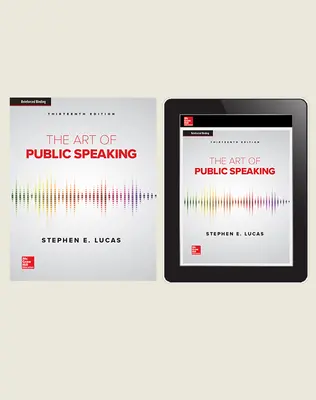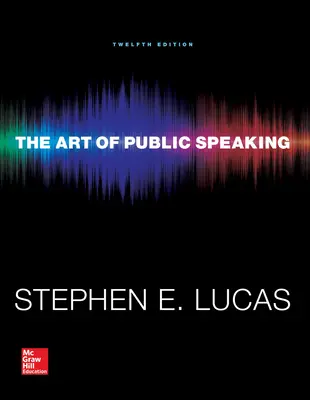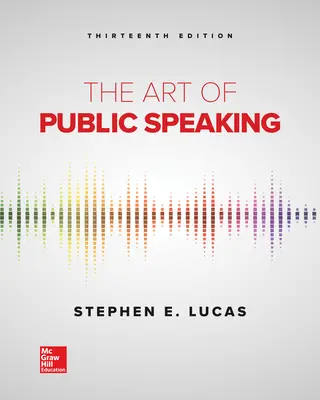A question that the audience answers mentally rather than out loud. Tap card to see definition.
Sometimes becomes apparent after you have done your research reveals more about the speech content than th specific purpose does and sharpens the focus of the specific purpose.

. Unlike static PDF The Art of Public Speaking 12th Edition solution manuals or printed answer keys our experts show you how to solve each problem step-by-step. A market is customers who have the power to purchase. Chapter 16 Review 1.
Public speaking is a form of power and therefore carries with it heavy ethical responsibilities. Identify and discuss four of the basic. A preview statement is a statement in the introduction of.
3 Practice the speech aloud several times using only the speaking outline. Charts and graphs pique interest and take the whole focus off the speaker. Martin Luther King Jr President John F.
There are subjects the student knows a lot about and those that the student wants. A speaker can make their message come alive and be immediately understandable with the right visual aid. Ethics and Public Speaking gives guidelines for ethical speaking gives guidelines for making sure that the message of the speech is ethical.
Kennedy or Attorney General Robert F. Start studying Public Speaking-Chapter 10-Review Questions. Since an audience trusts that a speaker is presenting facts and not half-truths all.
Why is a strong sense of ethical responsibility vital for public speakers. 2 Prepare your speaking outline. Putting a speech together in a particular way to achieve a particular result with a particular audience.
Tap card to see definition. 1 Go through your preparation outline aloud to check how what you have written translates into spoken discourse. A statement in the introduction of a speech that identifies the main points to be discussed in the body.
Your audience knows how and why you are qualified to speak on. By ethical standards a speaker should be well-versed on the topic and prepared for the speech. What are the five guidelines for ethical speechmaking discussed in this chapter.
You can check your reasoning as you tackle a problem using our interactive solutions. Emphatic listening and comprehensive listening. 5 Finally give your speech a dress rehearsal under conditions as close.
Get the attention of the audience reveal the topic establish credibility and goodwill preview the body of the speech. Speaking in Public One who forms a judgment on any point but cannot explain it clearly might as well never have thought at all on the subject Public speaking is the way of making your ideas public sharing them with others and influencing people Speeches should be clear well reasoned compelling and articulate Oldest known handbook. Most speeches contain 2-5.
The two kinds of listening most closely tied to critical thinking are Chapter 3 answer choices. What is the difference between global plagiarism and patchwork plagiarism. Having visual aids lends credibility to the speaker who comes off as professional and prepared.
Click again to see. Click card to see definition. Most people are very poor listeners because their minds are filled with distractions.
Art of Public Speaking Chapter 1. The major points developed in the body of a speech. 1 Relate the topic to the audience 2State the importance of.
The introduction is the speakers opportunity to create a favorable first impression for the audience. Briefly explain the following statement. Selecting a Topic begins by stating that choosing a topic for a public speech is not difficult.
Click again to see term. Ethics and Public Speaking. Using visual aids during a speech serves many purposes.
Tap again to see term. Tap card to see definition. A conclusion in which the speech builds to a zenith of power and intensity.
Without marketing research an entrepreneur would have no idea what type of business venture to take on. Chapter 1- Speaking in Public. Sullivan 1 Alexa Sullivan Public Speaking MW2 17 October 2018 The Art of Public Speaking.
The choice of subject will depend on the venue and the occasion. A method of speech organization in which the main points follow a time pattern. Comprehensive listening and critical listening.
Review the approaches that Aristotle Cicero and Quintilian held toward rhetoric then identify and compare and contrast the similarities and differences between them and how these differences advanced the art of public speaking. Contains wording giving the general purpose states what the speaker wants to say and states what the speaker wants the audience to know. 0ygew 8li vx sj 4yfpmg 7tieomrk 8irxl hmxmsr ikmrrmrk erh rhmrk xli 7tiigl 8ix 8li 1gvenmpp sqtermiw eyhmirgi mpp rsvqepp kmzi sy xlimv exxirxmsr -j.
The difference between an informative speech and a persuasive speech is that an informative speech only tells the audience about a topic with unbiased information while a persuasive speech involves the speaker trying to convince someone of an attitude or belief. However there are two main categories of potential topics for classroom speeches. 12 test answers.
15 test answers. In Chapter 10 the text takes the student through the process of crafting these two important parts of any speech. While the previous chapter gives a preview of good listening skills Chapter 3 is devoted to the topic.
Chapter 10 Review Questions 1. Kennedy and isolate one paragraph that you believe exemplifies a careful and effective use of languageRewrite that paragraph as I did for my classes using more common and less careful word choices. Greek leader one who forms a judgement on any point but cannot explain it might as well never have thought at all on the subject 93 of 300 employers said that the ability to think critically and communicate clearly is more important than the candidates undergraduate major.
What are the four objectives of a speech introduction. Click again to see term. The audiences perception of whether the speaker has the best interests of the audience in mind.
However becoming a good listener who accurately absorbs information presented by others is a skill which helps a public speaker to prepare an. Click card to see definition. Appreciative listening and emphatic listening.
The Art of Public Speaking Chapter 10 Beginning and Ending the Speech Notes Introduction Get attention and interest - Relate the topic to the audience - State the importance of the topic why should we care - Startle the Audience - Arouse their curiosity - Question the Audience - Begin with a Quotation - Tell a story Reveal the topic Establish credibility and goodwill tell the. No need to wait for office hours or assignments to be graded to find out where you took a wrong turn. The audiences perception of whether a speaker is qualified to speak on a given topic.
Learn vocabulary terms and more with flashcards games and other study tools. Up to 24 cash back Chapter 2. 1 gain the interest of the audience 2establish the speakers.
Just like a research paper a speech begins with an introduction and ends with a conclusion. 4 Now begin to polish and refine your delivery.

Touching Spirit Bear Novel Study Guide Touching Spirit Bear Novel Studies Study Guide

Quiz Worksheet Conveying Meaning With Vocal Qualities In Public Speaking Study Com

I Have Something To Say Mastering The Art Of Public Speaking In An Age Of Disconnection Kindle Edition By Bowe John Reference Kindle Ebooks Amazon Com

Lucas The Art Of Public Speaking C 2020 13e

Public Speaking For College Career

Amazon Cengage Advantage Series Essentials Of Public Speaking Hamilton Cheryl 9781285159454 Books

The Art Of Public Speaking How To Give Great Speeches Futurelearn


0 comments
Post a Comment